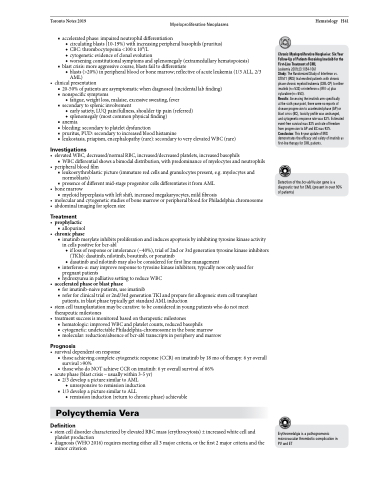Page 581 - TNFlipTest
P. 581
Toronto Notes 2019 Myeloproliferative Neoplasms
■ accelerated phase: impaired neutrophil differentiation
◆ circulating blasts (10-19%) with increasing peripheral basophils (pruritus)
◆ CBC: thrombocytopenia <100 x 109/L
◆ cytogenetic evidence of clonal evolution
◆ worsening constitutional symptoms and splenomegaly (extramedullary hematopoiesis)
■ blast crisis: more aggressive course, blasts fail to differentiate
◆ blasts (>20%) in peripheral blood or bone marrow; reflective of acute leukemia (1/3 ALL, 2/3
AML)
• clinicalpresentation
■ 20-50% of patients are asymptomatic when diagnosed (incidental lab finding) ■ nonspecific symptoms
◆ fatigue, weight loss, malaise, excessive sweating, fever ■ secondary to splenic involvement
◆ early satiety, LUQ pain/fullness, shoulder tip pain (referred)
◆ splenomegaly (most common physical finding) ■ anemia
■ bleeding: secondary to platelet dysfunction
■ pruritus, PUD: secondary to increased blood histamine
■ leukostasis, priapism, encephalopathy (rare): secondary to very elevated WBC (rare)
Investigations
• elevatedWBC,decreased/normalRBC,increased/decreasedplatelets,increasedbasophils
■ WBC differential shows a bimodal distribution, with predominance of myelocytes and neutrophils
• peripheralbloodfilm
■ leukoerythroblastic picture (immature red cells and granulocytes present, e.g. myelocytes and
normoblasts)
■ presence of different mid-stage progenitor cells differentiates it from AML
• bonemarrow
■ myeloid hyperplasia with left shift, increased megakaryocytes, mild fibrosis
• molecularandcytogeneticstudiesofbonemarroworperipheralbloodforPhiladelphiachromosome • abdominalimagingforspleensize
Treatment
• prophylactic
■ allopurinol
• chronicphase
■ imatinib mesylate inhibits proliferation and induces apoptosis by inhibiting tyrosine kinase activity in cells positive for bcr-abl
◆ if loss of response or intolerance (~40%), trial of 2nd or 3rd generation tyrosine kinase inhibitors (TKIs): dasatinib, nilotinib, bosutinib, or ponatinib
◆ dasatinib and nilotinib may also be considered for first line management
■ interferon-α: may improve response to tyrosine kinase inhibitors; typically now only used for
pregnant patients
■ hydroxyurea in palliative setting to reduce WBC
• acceleratedphaseorblastphase
■ for imatinib-naive patients, use imatinib
■ refer for clinical trial or 2nd/3rd generation TKI and prepare for allogeneic stem cell transplant
patients, in blast phase typically get standard AML induction
• stemcelltransplantationmaybecurative:tobeconsideredinyoungpatientswhodonotmeet
therapeutic milestones
• treatmentsuccessismonitoredbasedontherapeuticmilestones
■ hematologic: improved WBC and platelet counts, reduced basophils
■ cytogenetic: undetectable Philadelphia-chromosome in the bone marrow
■ molecular: reduction/absence of bcr-abl transcripts in periphery and marrow
Prognosis
• survivaldependentonresponse
■ those achieving complete cytogenetic response (CCR) on imatinib by 18 mo of therapy: 6 yr overall
survival >90%
■ those who do NOT achieve CCR on imatinib: 6 yr overall survival of 66%
• acutephase(blastcrisis–usuallywithin3-5yr) ■ 2/3 develop a picture similar to AML
◆ unresponsive to remission induction ■ 1/3 develop a picture similar to ALL
◆ remission induction (return to chronic phase) achievable
Polycythemia Vera
Definition
• stemcelldisordercharacterizedbyelevatedRBCmass(erythrocytosis)±increasedwhitecelland platelet production
• diagnosis(WHO2016)requiresmeetingeitherall3majorcriteria,orthefirst2majorcriteriaandthe minor criterion
Hematology H41
Chronic Myeloproliferative Neoplasias: Six Year Follow-Up of Patients Receiving Imatinib for the First-Line Treatment of CML
Leukemia 2009;23:1054-1061
Study: The Randomized Study of Interferon vs. STI571 (IRIS) trial enrolled patients with chronic phase chronic myeloid leukemia (CML-CP) to either imatinib (n=533) or interferon-α (IFN -α) plus cytarabine (n=553).
Results: Assessing the imatinib arm specifically
at the sixth year point, there were no reports of disease progression to accelerated phase (AP) or blast crisis (BC), toxicity profile was unchanged, and cytogenetic response rate was 82%. Estimated event-free survival was 83% and rate of freedom from progression to AP and BC was 93%. Conclusion: This 6-year update of IRIS demonstrates the efficacy and safety of imatinib as first-line therapy for CML patients.
Detection of the bcr-abl fusion gene is a diagnostic test for CML (present in over 90% of patients)
Erythromelalgia is a pathognomonic microvascular thrombotic complication in PV and ET


